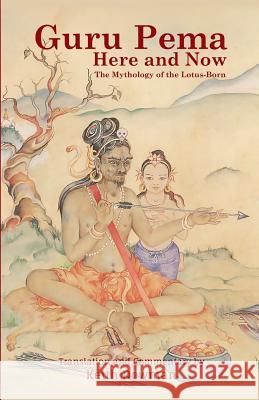Guru Pema Here and Now: The Mythology of the Lotus Born » książka
Guru Pema Here and Now: The Mythology of the Lotus Born
ISBN-13: 9781507662953 / Angielski / Miękka / 2015 / 358 str.
Guru Pema is Padmasambhava, the wandering tantric yogin from Orgyen who became Tibet's Great Guru. To his disciples he was the Lotus Born and, later, to his followers, he became Guru Rimpoche, the precious guru-buddha who resides in our heart center. Identical to the nature of mind, he emanates tulkus to demonstrate Dzogchen, the Great Perfection. In this ground-breaking work Keith Dowman brings the guru-myths and the means of invoking Guru Pema together with an analysis provides immediate contemporary meaning. Some readers will consider the mythic truths revealed in the lives of Guru Rimpoche described in the Zanglingma, a treasure-text of Nyangrel Nyima Wozer, as the core of the book. Others will look at The Seven Line Prayer as the essence because Mipham Namgyel's commentary provides the secret means to personal attainment of union with Guru Rimpoche. In a similar way that Mipham elucidates the hidden meanings of The Seven Line Prayer, exposing the treasures that have lain hidden in a common prayer that everyone knows and hitherto has taken at face value, so the extensive introduction written in Keith Dowman's inimitable style and perspective, brings Padmasambhava into the twenty-first century and actually verbalizes what we have hitherto only surmized. The guru-myths are presented as code describing the manner in which Guru Pema's enlightenment works for us and how his activity works for the sake of others. The stories of the Guru's life are thus paradigmatic, exemplary models, to be emulated by his yogin-followers and a source of inspiration and faith for his devotees. At the same time the narrative of the Zanglingma describes the events in Padmasambhava's life that comprise the early history of Buddhist Tibet but this is secondary to the main theme - an exposition of Dzogchen vision, meditation and action. The book is illustrated by reproductions of the Eighth Khamtrul Rinpoche's exceptional blockprints of the 'Eight Names of the Guru', extensive appendixes provide historical background, and glossaries and an annotated index serves instead of notes. Keith Dowman is now dedicated to the teaching and translation of Dzogchen. In the 'sixties, however, as a genyen practitioner training under his principle teachers, Dudjom Rimpoche and Kanjur Rinpoche. In that sadhana the mythology of Guru Pema provided the inspiration and The Seven Line Prayer a skilful means to attainment of union with the Guru. This work is an acknowledgement of the importance of that early training. The original texts are unchanging; the interpretation changes according to the needs of the times and individuals. Keith Dowman's translations are true to the Tibetan while his commentary seems to fit the moment. Bhakha Tulku Pema Rigdzin. The Precious Guru, the Lotus Born, rests at the vital heart of Tibetan Buddhism. Renowned translator Keith Dowman, in his uniquely fluid style, has gathered here a superb collection of key texts presenting the legends and inner significance of the Great Guru. For beginners, an exceptional introduction, and for the old hands who realize that they are still and will always be beginners, a volume to savor. Matthew Kapstein, Directeur d'etudes, Ecole Pratique des Hautes Etudes; Numata Visiting Professor of Buddhist Studies, The University of Chicago. "Keith Dowman, one of our treasured lotsawas, has prepared for us another feast of wisdom and delight with this beautiful version of the wondrous story of Guru Rinpoche, the buddha-emanation always ready to help us in our present age of degeneracy. I love this work, and heartily recommend it for everyone who loves life, loves Tibet, wants to share its culture to benefit all sensitive beings, and persists in the undying hope that things must work out well for all of us on this little planet lost in space among the stars. Bob Thurman, author, activist President of Tibet House US.
Zawartość książki może nie spełniać oczekiwań – reklamacje nie obejmują treści, która mogła nie być redakcyjnie ani merytorycznie opracowana.











